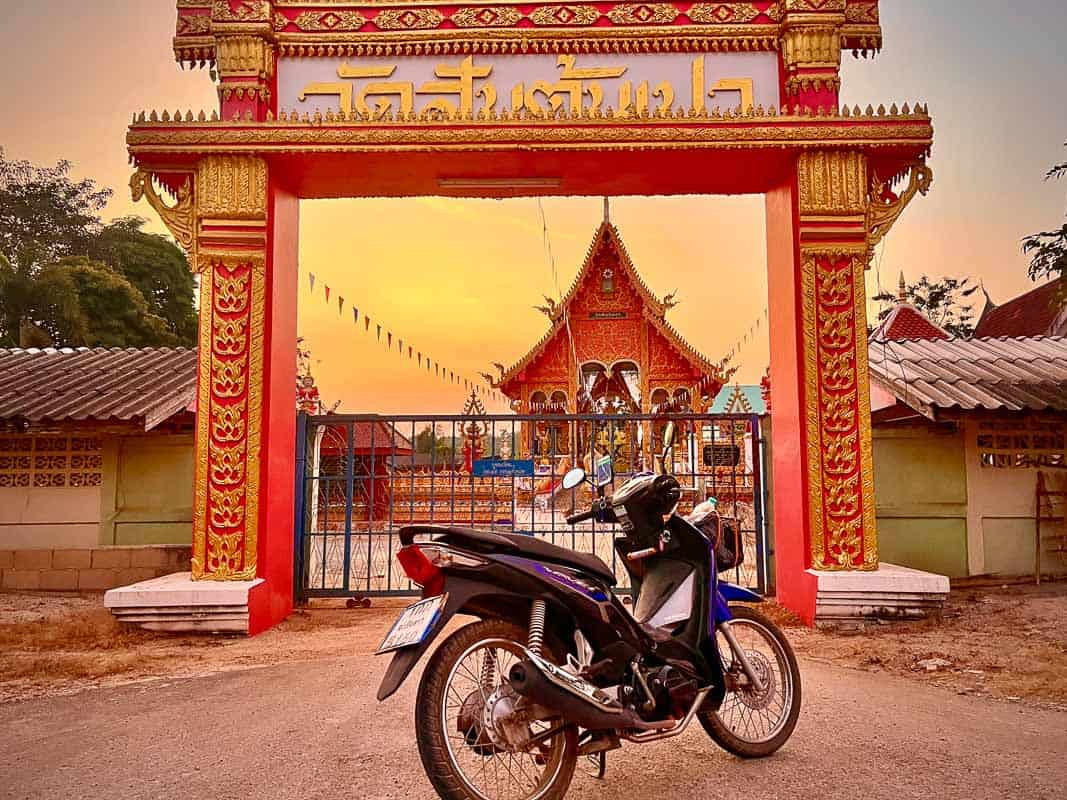Renting a Scooter in Thailand: 10+ Helpful Tips Before You Sign

Do you need a license to rent a scooter in Thailand?
How much does a scooter cost in Thailand?
Which scooter option is right for me based on the adventures I want to have?
Even being a self-proclaimed Southeast Asia expert scooter rider, these questions still pop up for every new country I visit, Thailand included. The good thing is in Thailand, renting a scooter is relatively hassle-free and extremely common.
Ensure you’re on the legal side of things by reading this comprehensive guide to scooter rentals in Thailand. We’ll tell you who can (and cannot) rent, what documentation you need, costs, avoiding police checks, and more. Here’s everything you need to know about renting a scooter in Thailand.
Easily Plan Your Trip with Some of My Favorite Resources Below!
► Cheapest Accommodation– I Always Use Booking.com
► Adventurous Tours– I Recommend Viator.com
► Car Rental– I Always Use DiscoverCars.com

Why Rent a Scooter in Thailand?
Aside from Bangkok, which has an extensive public transportation system and terrible traffic, renting a scooter is ideal for almost every other place in Thailand. It’s the absolute best way to get around any city and gives you the flexibility to visit nearby famous attractions easily.
With a scooter, bypass the sometimes horrible traffic in market areas in Chiang Mai. Drive between new and old Sukhothai easily, tour Chiang Rai from Chiang Mai, or even do a Laos border run at the Golden Triangle area yourself. Or, if you’re in the south, you can easily visit the little-visited hidden beaches of northern Koh Phangan or Railey.
First Time Driver?
Don’t worry if this is your first time driving a scooter. Unlike renting scooters in traffic-packed Vietnam cities or Indonesia’s steep volcano roads, Thailand’s road conditions are pretty decent. Try first on an empty road or parking lot to give yourself some practice time. Especially on an automatic scooter, there’s little more than getting the balance down.
Once you add a passenger or your 65L backpacking bag, you will definitely feel the difference. Make sure you are comfortable with the handling of the vehicle before adding any significant weight or anything that restricts your movement.
Alternatives to Renting a Scooter in Thailand
Let’s face it, a tiny, two-wheeled vehicle going 80km on a highway may not be for everyone. There’s no need to push yourself if you’re uncomfortable, or maybe you have a big group or are traveling long distances. What other options do you have?
- Grab – The Southeast version of Uber is the Thai go-to ridesharing app.
- Tuk Tuk and Motortaxi – The Thai version of a cab. They will hang around popular areas like bus stations and tourist attraction entryways. – Check out this 5 star tour through Bangkok’s markets and temples via Tuk Tuk here
- Songthaews – Usually red (but sometimes yellow or white) local minibusses that run along a mostly predetermined path. They may be willing to make a detour for a small fee.
- 12 Go Asia – The most reliable and convenient way to book tickets for long-distance public transport travel in Thailand.
- Rental Car – Look for the most up-to-date best rental rates in Thailand here.
- Hire a Private Driver – Private transport may be a better option for inter-city travel or airport transfers, especially for larger groups or families. You can even find tons of ferries to get you to best islands of Thailand. Book online transport for dozens of locations in Thailand beforehand here.
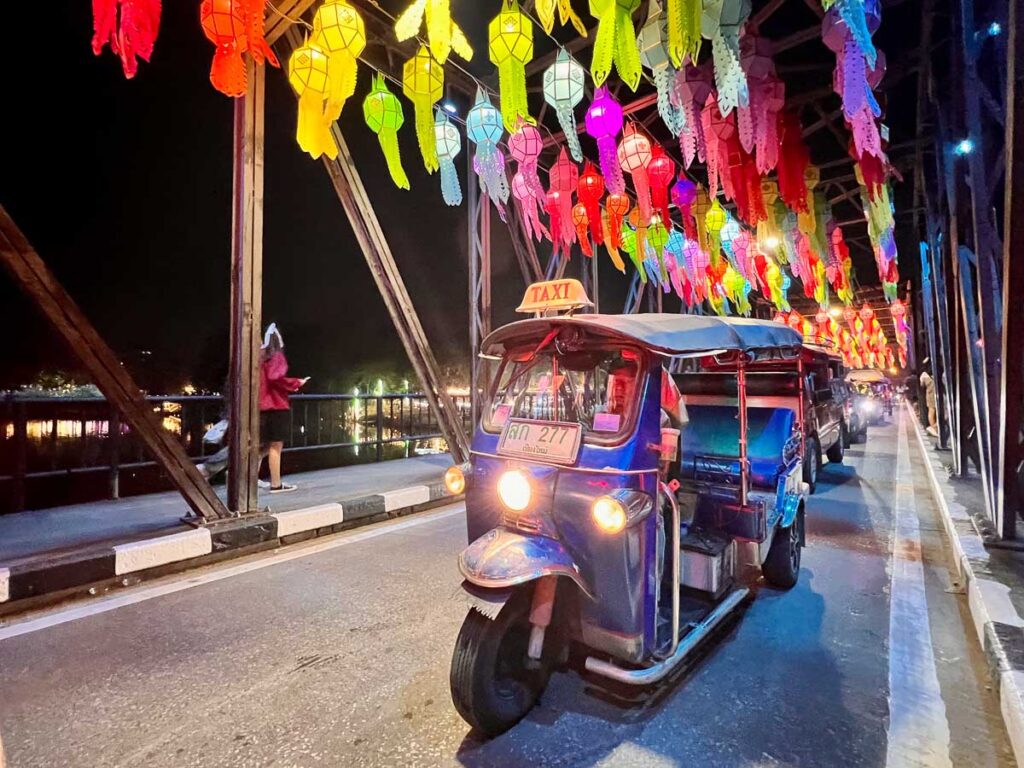
Tips to Know Before Renting a Scooter in Thailand
The main takeaway from this post should be to use caution when renting a scooter in Thailand. (Try to) respect the rules of the country, even if they aren’t always enforced or if the police are trying to get some lunch money (aka bribery).
1. Wear a Helmet Always! Including the Passenger
Helmets are the number one reason that police will pull you over and hand you over a ticket. Why? Because it is the most obvious thing to pull you over for.
My first ticket in Thailand was not due to me (the driver not wearing a helmet), but this random guy I picked up at the market as my passenger not wearing a helmet. So I guess they need one too. Also, this is not just exclusive to foreigners; Thai people will get pulled over for non-helmet-wearing compliance too.
You can get away with not wearing a helmet much easier if you are scooting around the southern islands. Still, for safety reasons, you should always wear one anyways. Your life is more important than looking cool or having a bad hair day.
2. Always Keep your International Driver’s License or Permit On You
I’ll be the first to say that I personally don’t have an international driver’s license, but driving without one is illegal. You will get ticketed for not having one (unless you have a Thai driver’s license).
Thai scooter rental places largely don’t check to see if you have an international driver’s license before renting to you. They’ll rent their scooters to anyone without checking anything.
Regular police roadblocks are set up in specific areas to help reduce the number of traffic accidents. The issue with driving a scooter without an IDP isn’t renting it–it’s getting pulled over by the police.
How to Get an International Driver’s License
An International Driving Permit is simply a translation of your driver’s license into multiple languages.
It’s actually super easy to apply for most countries, and there’s no need for extra testing, and the process won’t take very long or cost much. The problem is, if you are already abroad, international driver’s licenses can only be issued in your home country.
3. How To Handle the Police Checkpoints
The three main reasons cops will stop you are:
- Is everyone wearing a helmet?
- Do you have an international driver’s license?
- Are you sober?
If you are good to go with all three, then the police will send you off with a slight disappointment on their faces. If not, they will ticket you for something, anything. And with so many checkpoints, you probably will get stopped at some point if you are riding for an extensive period of time.
Tickets will generally run 400-500 baht (11-14 USD) and up to 1000 baht (28 USD). If they are charging 1000 baht, I would argue with them right there and then. And make sure you refrain from giving money to the police officer directly. Ask to pay at the police station.
Side Note: I have heard of parking tickets fining up to 1100 baht.
Before riding a scooter, ask your hostel or other guests where the known checkpoints are to avoid. If you see a checkpoint and know you are not compliant, I would literally make a U-turn right there rather than risk getting stopped.
4. Check Before You Go! A Bad Bike Will Give You Problems
Fun Travel Story: I once rented a scooter in Nusa Lembongan, Bali, where the frame literally cracked in half, and I had to walk-drive it back 5 miles! If I had just checked how badly it was rusted, I could’ve avoided that whole mess.
Before riding off on your newly rented scooter, do a complete vehicle inspection. Make sure to document (with pictures) any dents, scratches, or other areas of damage.
Also, check that all the indicator lights and breaks are working properly. That way, if there are any issues when you return the scooter, you can show that the damage was done beforehand.
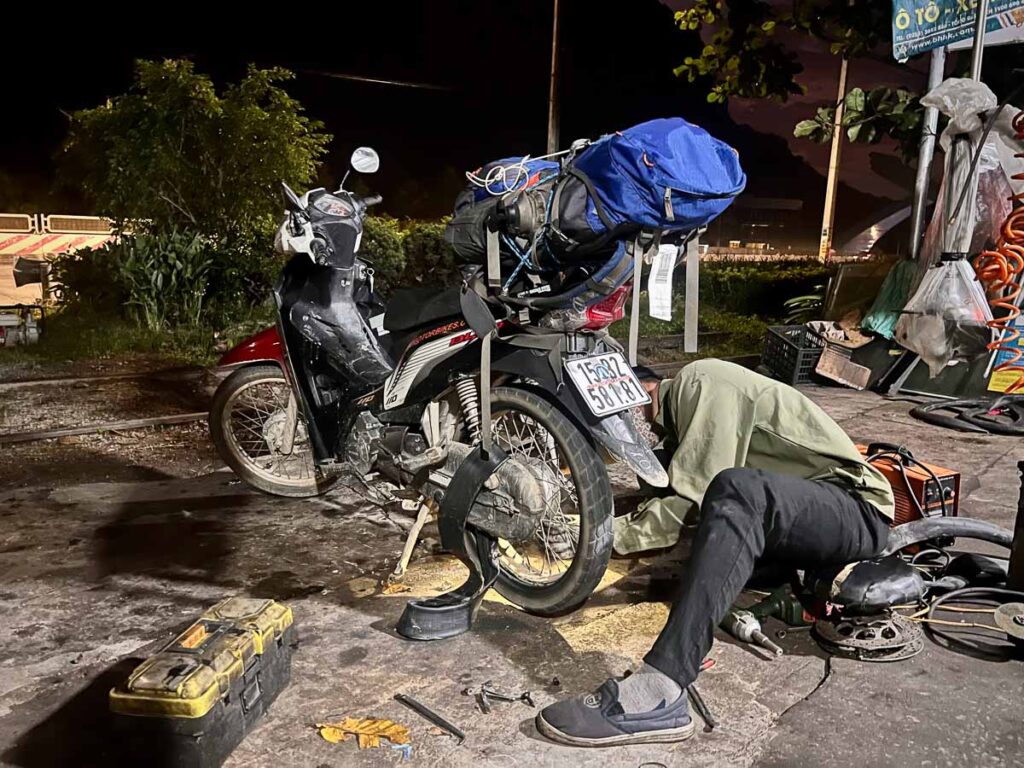
5. Where To Rent a Scooter
- Pre-book at an Online Travel Agency
- Scooter Rental Shop
- Your Accommodation (maybe)
During the high season in Thailand, it’s best to call ahead and check with several shops. In those times, bikes can be scarce in popular destinations like Koh Phangan, Pai, and Chiang Mai. You don’t want to waste time visiting shop after shop only to find that they’re all out of bikes.
The reason for the scarcity I had gotten is the classic case of supply-demand misalignment due to the resurgence of tourist demand in recent years.
How to Spot the Bad Rental Companies
Unfortunately, there are always bad players and scam motorbike rental shops that charge an arm and a leg for everything. Fortunately, we have reviews now. The best way to avoid a bad experience is to check for good reviews and the fine print of your rental contract beforehand.
Before you go! Always ask about the scooter’s paperwork and keep it in the trunk of the scooter, especially if you are going far distances.
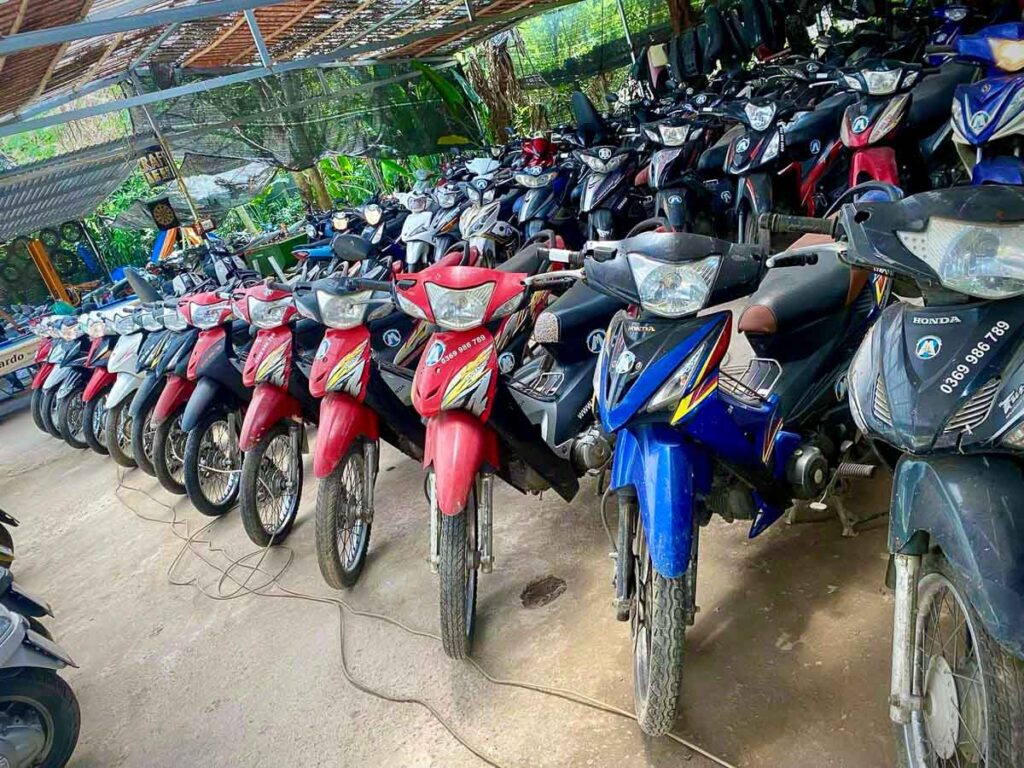
6. Process of Renting a Scooter in Thailand: Deposit and Forms
Depending on where you go, the process can be very formal or shockingly disorganized.
Highly reviewed, larger scooter rental shops will have a large selection of bikes, helmets in all sizes, a formal registration process, a payment receipt, a set deposit, and fee.
Smaller places, or if you are renting from your accommodation, can be the complete opposite. They may ask for nothing except a deposit. You can typically deposit 2000-5000 baht cash or temporarily surrender your passport. Most shops will not ask to see any driver’s licenses and do not accept credit cards.
7. Scooter Rental Options in Thailand
The size of the rental company you rent from will largely determine the type of bike options available, ranging from small city electric scooters to larger adventure manual motorcycles.
Here are the most common types of scooters and motorbikes
Weak, Electric Scooters for Inner-City: These machines are nimble, light, and easy to drive, don’t expect them to have much power or whisk you away at high speed. Larger shops with more bikes are more likely to have them.
👉 Interested in going even smaller? Check out this e-scooter tour through the best of Bangkok
Fino/Scoopy/Moove 110cc: These scooters are more compact than average, have a smaller storage area, and are ideal for inner-city travel. They’re better suited for day trips around town and can struggle with hilly terrain. Many times these are the cheapest option if electric scooters aren’t available.
Click/Vario/GT/Filano 125cc: These scooters have more power than the 110cc, which you can feel, especially when going up more mountainous, windy roads. It still gets uncomfortable after driving many hours, but it will get you wherever you’re going.
Honda Wave 110cc-125cc (semi-automatic): Since my experience with these semi-automatic bikes from northern Vietnam’s epic Ha Giang Loop, I have been in love with them. The bike has gears but no clutch, making it more flexible and great for both the city and longer trips. However, they have terrible trunk storage capacity.
Various 150cc Options: Very comfortable and with a huge trunk capacity, these big boys are made for comfort for longer cross-country trips. I can fit nearly half my backpack in the trunk! They’ve got lots of power but may be too heavy for beginner riders or short people (like me).
Manual Motorcycles: This will be the most powerful and most expensive option of all. Recommended only for people with experience and who want to go on an overland tour of Thailand.
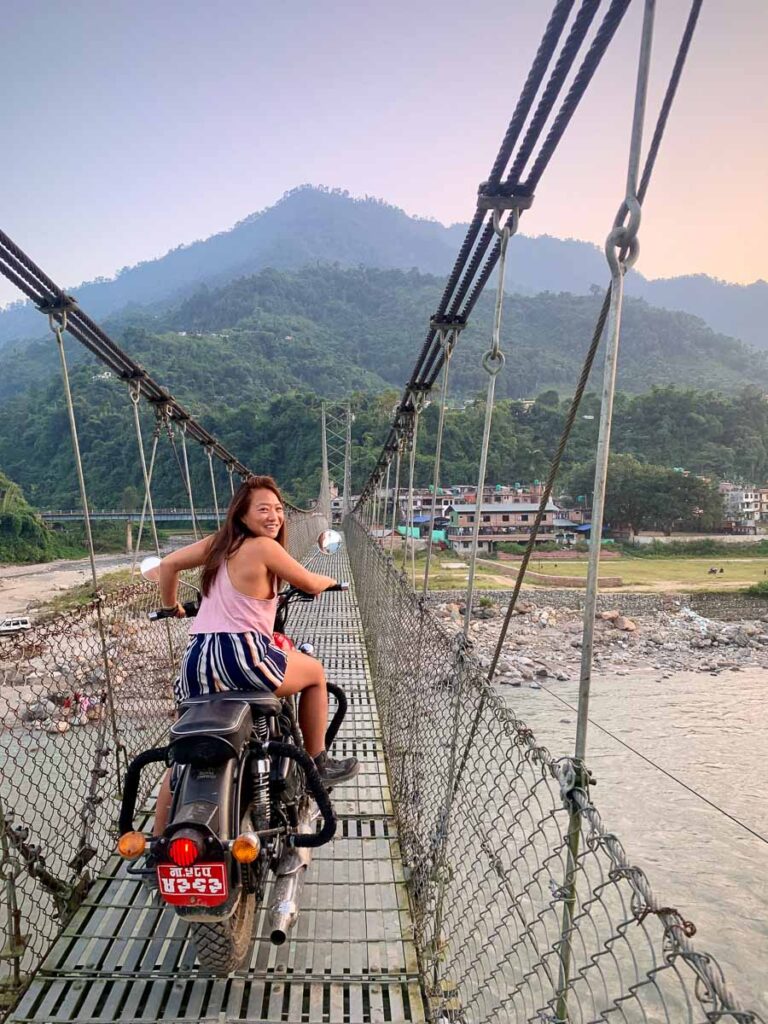
8. Cost of Renting a Scooter in Thailand
The cost of a bike in Thailand largely depends on your geographical location. Prices are generally lower up north than down south. For example, you may find that sometimes Bangkok compared to Chiang Mai could be almost double in price.
When I traveled there in 2018, finding rental scooters for only 100 baht per day was easy. However, these days such a deal is rare to impossible to find.
Daily Rates of Popular Tourist Places in Thailand
Here are the starting average prices of motorbike rentals in various popular locations around the country. These are for the most common type of bike, automatic scooters 110cc-125cc.
- Chiang Mai: 250 baht
- Pai: 150-200 baht
- Bangkok: 250-300 baht
- Pattaya: 200 baht
- Koh Phangan: 250 baht
- Phuket: 250 baht
The daily rental rates for scooters in Thailand are usually firm, especially in the touristy central areas. You may have more luck negotiating in lesser-visited towns or city suburbs.
For the short-term, the rental price doesn’t vary enough for you to spend significant effort saving 50 Thai baht.
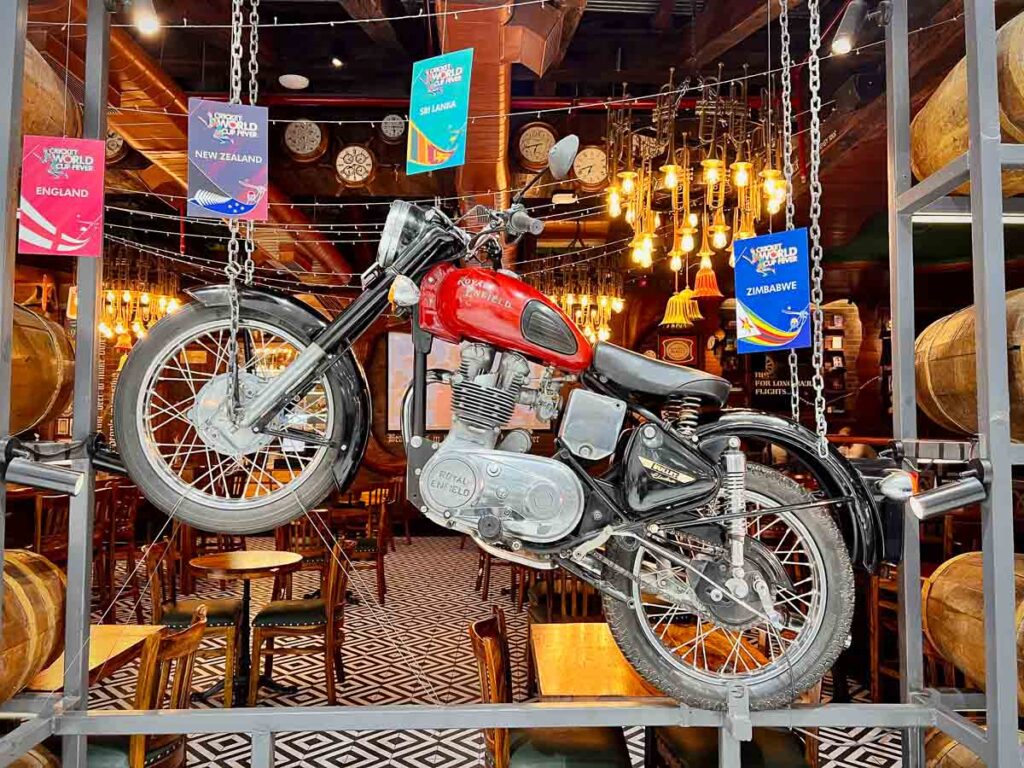
Costs for Long-Term Scooter Rental in Thailand
Staying in one place in Thailand for a week, a month, or more? You can get great discounts on scooter rentals if you’re renting for a more extended period. Weekly rentals have small discounts, while monthly rentals have much steeper discounts.
Like daily rates, the long-term rental costs can vary depending on the shop, the condition and type of vehicle, and where you are in the country.
The prices listed below are what you can expect to pay for long-term bike rental in Thailand. However, it is possible to get a lower price than the market price by scouring the internet and Facebook expat groups.
Weekly Rental Rates:
You can expect the weekly rental rate to be around 15%-25% discounted from the daily rate. For the cheapest types of bikes, this ends up ranging from 1200-1800 baht per week. Again the variation depends mostly on which city you are renting from.
Monthly Rental Rates
This is where you really save. The monthly option is already worth it in many places if you plan on renting for longer than 10 days.
Monthly discounts can range from 40%-60% off the daily rate. For instance, I rented a Honda Wave for 3250 baht per month, where the daily rate is 250 baht per day.
In all of Thailand, the cheapest monthly rentals start as low as 3000 baht, but around the 4000 mark is much more common. Not all companies offer monthly rentals.
If you plan on renting an apartment for your stay, ask the owner if they have an extra bike they may throw in as a combo package deal. I’ve heard of deals like this for as little as 1500 baht per month on top of their apartment rental prices.
Additional Costs To Consider
Some rental companies may offer insurance for a daily extra cost and will cover everything in case of motorbike accidents. This is only sometimes provided, but may be a good idea if you want to feel more reassured. Also, check with your travel insurance to see what is and isn’t covered.
Some instances, like the route from Pai to Chiang Mai, offer one-way rentals. You only rent one way, but you don’t need to return it to the original shop.
9. Fuel Fill-Ups
The two petrol types that can be used for scooters are 91 and 95 grade, costing approximately the same price of ฿35-37/liter (roughly $1 USD/liter) at most refueling stations.
Honda Varios estimates it can travel about ~50 kilometers per liter of fuel. The most common bikes hold about 4-6 liters of fuel, so you can do the math there.
Unlike countries like Indonesia or Vietnam, you don’t see many small shops selling hand pump gas or bottles of petrol on the street.
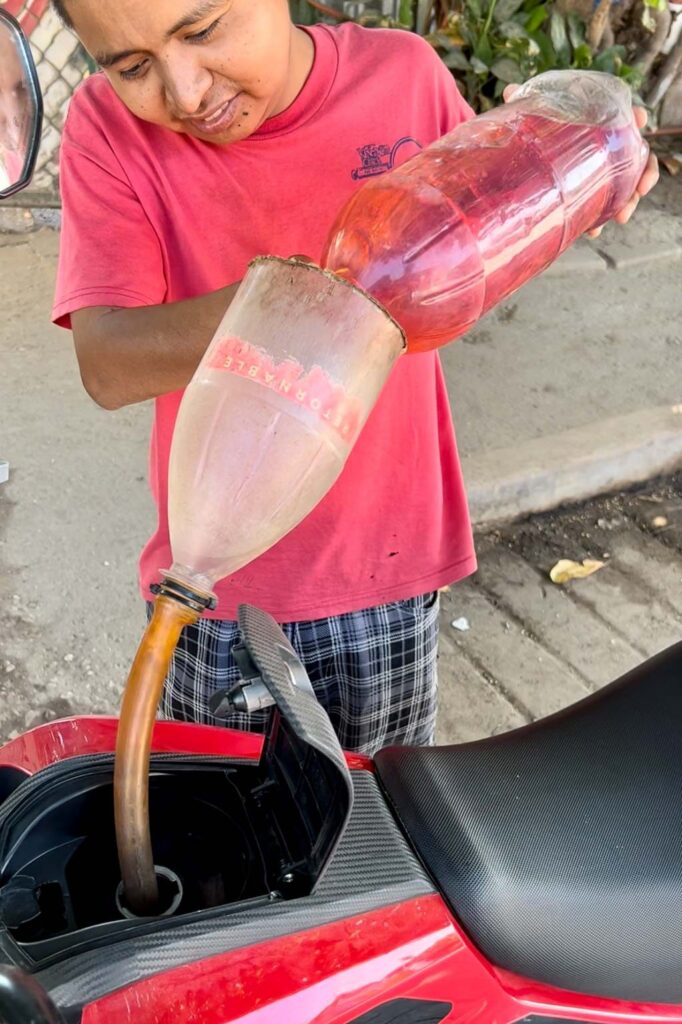
Other Tips for Renting a Scooter in Thailand
- Select the motorbike route when using your online maps, just in case will avoid any car-only expressways.
- In Thailand, people drive on the left side of the road.
- Unlike other Southeast Asian countries, people don’t honk in Thailand very much. In mountain road conditions, honking will still be used as a safety measure.
- If renting a scooter during Thailand’s rainy season, keep a rain jacket or poncho underneath your seat.
- Protect yourself from the sun. The last thing you want is to come home with an unwanted souvenir: a painful sunburn.
- Although you should always get travel insurance, your insurance company won’t likely cover your damages if you’re in a motorbike accident without an international driver’s license.
- Make sure you take the rental services phone number in case of an accident.
Final Thoughts: Thailand Scooter Rental
Renting scooters in Thailand can be an incredible way to explore the country and its many attractions. However, it is crucial to consider your safety, experience level, and local laws before signing up for one of these rentals.
With these tips, you should have no problem finding the perfect rental (and avoid police fines) for your next Thailand adventure!
| TRAVEL RESOURCES |
| ✈️ Find the best tours and activities with Viator to cross off your bucket list and create unforgettable memories 🏘️ Book your accommodation with Booking.com in advance and check availability on the days of your travels. 🧾 Rent a car in advance with Discovercars for those epic road trips at the best price. |
Where Next in South Thailand?
I’ve been to Thailand 10+ times in my life and now spend my winters there. Check out these other posts to see if any of these destinations pique your interest.
- Phuket To Krabi: 7 Ways To Get There Via Land & Sea
- 7 Best Phi Phi Island Tours from Phuket
- Koh Phayam, Thailand: A No FOMO Guide To One Of The Best Thai Islands
- To Phi Phi Island From Phuket: How To Get There Via Ferry & Speedboat
- Bangkok To Ayutthaya: How To Get There Via Train, Minibus, & Tour
Have Travel Questions About Thailand? Maybe I’ve Answered Them
- Languages Spoken In Thailand: Do They Speak English In Thailand?
- Motorbike Rental In Phuket: 9 Quick Tips Before You Sign
- Is There Uber In Thailand? (Uber In Bangkok And Beyond)
- 30 Day Tourist Visa Extension Thailand: Step-By-Step Guide
- Price Of Massages In Thailand: Honest Rates For All Types Of Massages
- Chiang Khong To Huay Xai: How To Cross The Thailand-Laos Border
- Bangkok vs Chiang Mai: Thai-Ing To Decide Which City Is Better?
Catherine Xu is the founder and author of Nomadicated, an adventure travel blog that helps travelers cross off their bucket list. Since discovering traveling in 2015, she has lived and journeyed to 65 countries across 5 continents and vanlifed the west coast USA for 2+ years. These days, she splits her time in Southeast Asia and California while sharing her travel stories and resources based on first-hand experiences. Catherine's other works has been referenced in major publications like MSN, Self, and TripSavvy.

